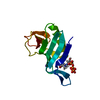+Search query
-Structure paper
| Title | Structural and functional characterization of the severe fever with thrombocytopenia syndrome virus L protein. |
|---|---|
| Journal, issue, pages | Nucleic Acids Res, Vol. 48, Issue 10, Page 5749-5765, Year 2020 |
| Publish date | Jun 4, 2020 |
 Authors Authors | Dominik Vogel / Sigurdur Rafn Thorkelsson / Emmanuelle R J Quemin / Kristina Meier / Tomas Kouba / Nadja Gogrefe / Carola Busch / Sophia Reindl / Stephan Günther / Stephen Cusack / Kay Grünewald / Maria Rosenthal /   |
| PubMed Abstract | The Bunyavirales order contains several emerging viruses with high epidemic potential, including Severe fever with thrombocytopenia syndrome virus (SFTSV). The lack of medical countermeasures, such ...The Bunyavirales order contains several emerging viruses with high epidemic potential, including Severe fever with thrombocytopenia syndrome virus (SFTSV). The lack of medical countermeasures, such as vaccines and antivirals, is a limiting factor for the containment of any virus outbreak. To develop such antivirals a profound understanding of the viral replication process is essential. The L protein of bunyaviruses is a multi-functional and multi-domain protein performing both virus transcription and genome replication and, therefore, is an ideal drug target. We established expression and purification procedures for the full-length L protein of SFTSV. By combining single-particle electron cryo-microscopy and X-ray crystallography, we obtained 3D models covering ∼70% of the SFTSV L protein in the apo-conformation including the polymerase core region, the endonuclease and the cap-binding domain. We compared this first L structure of the Phenuiviridae family to the structures of La Crosse peribunyavirus L protein and influenza orthomyxovirus polymerase. Together with a comprehensive biochemical characterization of the distinct functions of SFTSV L protein, this work provides a solid framework for future structural and functional studies of L protein-RNA interactions and the development of antiviral strategies against this group of emerging human pathogens. |
 External links External links |  Nucleic Acids Res / Nucleic Acids Res /  PubMed:32313945 / PubMed:32313945 /  PubMed Central PubMed Central |
| Methods | EM (single particle) / X-ray diffraction |
| Resolution | 1.35 - 3.78 Å |
| Structure data | EMDB-10706, PDB-6y6k:  PDB-6xya: |
| Chemicals |  ChemComp-MGP:  ChemComp-NA:  ChemComp-HOH:  ChemComp-MG: |
| Source |
|
 Keywords Keywords |  VIRAL PROTEIN / VIRAL PROTEIN /  bunyavirus / cap binding / cap-snatching / viral polymerase / bunyavirus / cap binding / cap-snatching / viral polymerase /  Phenuiviridae / L protein Phenuiviridae / L protein |
 Movie
Movie Controller
Controller Structure viewers
Structure viewers About Yorodumi Papers
About Yorodumi Papers






